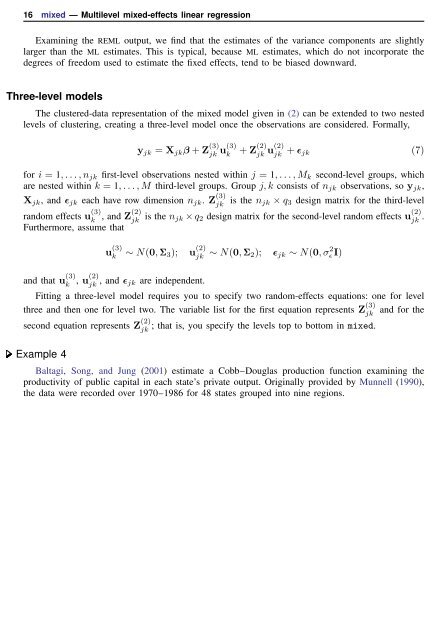mixed - Stata
mixed - Stata
mixed - Stata
Create successful ePaper yourself
Turn your PDF publications into a flip-book with our unique Google optimized e-Paper software.
16 <strong>mixed</strong> — Multilevel <strong>mixed</strong>-effects linear regression<br />
Examining the REML output, we find that the estimates of the variance components are slightly<br />
larger than the ML estimates. This is typical, because ML estimates, which do not incorporate the<br />
degrees of freedom used to estimate the fixed effects, tend to be biased downward.<br />
Three-level models<br />
The clustered-data representation of the <strong>mixed</strong> model given in (2) can be extended to two nested<br />
levels of clustering, creating a three-level model once the observations are considered. Formally,<br />
y jk = X jk β + Z (3)<br />
jk u(3) k<br />
+ Z (2)<br />
jk u(2) jk + ɛ jk (7)<br />
for i = 1, . . . , n jk first-level observations nested within j = 1, . . . , M k second-level groups, which<br />
are nested within k = 1, . . . , M third-level groups. Group j, k consists of n jk observations, so y jk ,<br />
X jk , and ɛ jk each have row dimension n jk . Z (3)<br />
jk<br />
is the n jk × q 3 design matrix for the third-level<br />
random effects u (3)<br />
k<br />
, and Z(2)<br />
jk is the n jk × q 2 design matrix for the second-level random effects u (2)<br />
jk .<br />
Furthermore, assume that<br />
u (3)<br />
k<br />
∼ N(0, Σ 3 ); u (2)<br />
jk ∼ N(0, Σ 2); ɛ jk ∼ N(0, σ 2 ɛ I)<br />
and that u (3)<br />
k<br />
, u(2) jk , and ɛ jk are independent.<br />
Fitting a three-level model requires you to specify two random-effects equations: one for level<br />
three and then one for level two. The variable list for the first equation represents Z (3)<br />
jk<br />
second equation represents Z (2)<br />
jk<br />
; that is, you specify the levels top to bottom in <strong>mixed</strong>.<br />
Example 4<br />
and for the<br />
Baltagi, Song, and Jung (2001) estimate a Cobb–Douglas production function examining the<br />
productivity of public capital in each state’s private output. Originally provided by Munnell (1990),<br />
the data were recorded over 1970–1986 for 48 states grouped into nine regions.
















